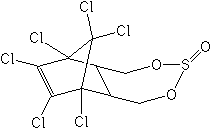-
Common NameEndosulfan
-
中文通用名硫丹
-
IUPAC(1,4,5,6,7,7-hexachloro-8,9,10-trinorborn-5-en-2,3-ylenebismethylene) sulfite; 6,7,8,9,10,10-hexachloro-1,5,5a,6,9,9a-hexahydro-6,9-methano-2,4,3-benzodioxathiepine 3-oxide
-
CAS6,7,8,9,10,10-hexachloro-1,5,5a,6,9,9a-hexahydro-6,9-methano-2,4,3-benzodioxathiepine 3-oxide
-
CAS No.115-29-7
-
Molecular FormulaC9H6Cl6O3S
-
Molecular Structure
-
Category
-
ActivityAcaricide/Miticide/Insecticide
-
PremixLambda-cyhalothrin+endosulfan+phoxim
Lambda-cyhalothrin+endosulfan
Fenpropathrin+endosulfan
Endosulfan+parathion-methyl
Endosulfan+methomyl
Endosulfan+lambda-cyhalothrin
Endosulfan+fenvalerate
Endosulfan+esfenvalerate
Endosulfan+dimethoate
Endosulfan+deltamethrin
Endosulfan+cypermethrin
Endosulfan+chlorpyrifos
Beta-cypermethrin+endosulfan
Dust, emulsifiable concentrate, granule, ULV, wettable powder.
-
Physical PropertiesMolecular weight:406.9; Physical form:Colourless crystals; (, cream to brown, mostly beige). Density:c. 1.8 (20 °C) (); Composition:Endosulfan is a mixture of two stereoisomers: alpha-endosulfan, endosulfan (I), stereochemistry 3a,5ab,6a,9a,9ab-, comprises 64-67% of the grade; beta-endosulfan, endosulfan (II Melting point:>80 °C (); a- 109.2 °C; b- 213.3 °C; Vapour pressure:0.83 (20 °C) for 2:1 mixture of a- and b- isomers; Henry constant:a- 1.48; b- 0.07 (both Pa m3 mol-1, 22 °C, ); Partition coefficient(n-octanol and water):logP for a- = 4.74; b- = 4.79 (both at 5); Solubility:In water alpha-endosulfan 0.32, beta-endosulfan 0.33 (both in /l, 22 °C). In ethyl acetate, dichloromethane, toluene 200, ethanol c. 65, hexane c. 24 (all in g/l, 20 °C).; Stability:Stable to sunlight. Slowly hydrolysed in aqueous acids and alkalis, with the formation of the diol and sulfur dioxide.;
-
ToxicologyOral:Acute oral
50 for rats 70 (in aqueous suspension)/ , 110 (in oil)/ , 76 alpha- isomer/ , Percutaneous:Acute percutaneous 50 for rabbits 359 (in oil)/ ; for male rats >4000, female rats 500 -
Environmental ProfileEcotoxicology:
HAZARDS: Fish, Bird: Toxic. Bee: Moderately toxic (direct application). Relatively nontoxic to beneficials.
Algae:50 (72 h) for green algae >0.56 /l.Bees:Not toxic to bees under field conditions at an application rate of 1.6 l/ (560 g endosulfan/ ).Birds:Acute oral 50 for mallard ducks 205-245, ring-necked pheasants 620-1000 / .Daphnia: 50 (48 h) 75-750 mg/l.Fish:Highly toxic ( 50 (96 h) for golden orfe 0.002 /l water) but, in practical use, should be harmless to wildlife.Worms: 0.1 / dry weight.
Environmental fate:
WATER SOLUBILITY: Tech insoluble
Animals:The principal route of elimination is faeces; most of the radioactivity is excreted within the first 48 hours. The amounts excreted are independent of dose level, number of dosages and isomerism. There are indications of species-specificity. Residues of eSoil:Endosulfan (alpha- and beta-) is degraded in soil with50 30-70 d. The main metabolite usually found was endosulfan sulfate, which is degraded more slowly and is, for this reason, the most important metabolite. -
Transport InformationSignal Word:DANGER-POISON; Hazard Class:Ia(Extremely hazardous)
Porduct NewsMore
China to suspend all registrations on endosulfan in 2011
Related CompaniesMore
Country: India
Zinc phosphide Aluminium phosphide Profenofos Glyphosate Tebuconazole Chlorpyrifos Fluroxypyr Chlorpyrifos+cypermethrin Cypermethrin+profenofos Tebuconazole+Sulphur Sulphur
Coromandel International Limited
Country: India
Mancozeb Propineb Azoxystrobin Maneb Acephate Profenofos Phenthoate Malathion Pyrazosulfuron-ethyl Glyphosate
Country: India

 0
0 Subscribe
Subscribe
